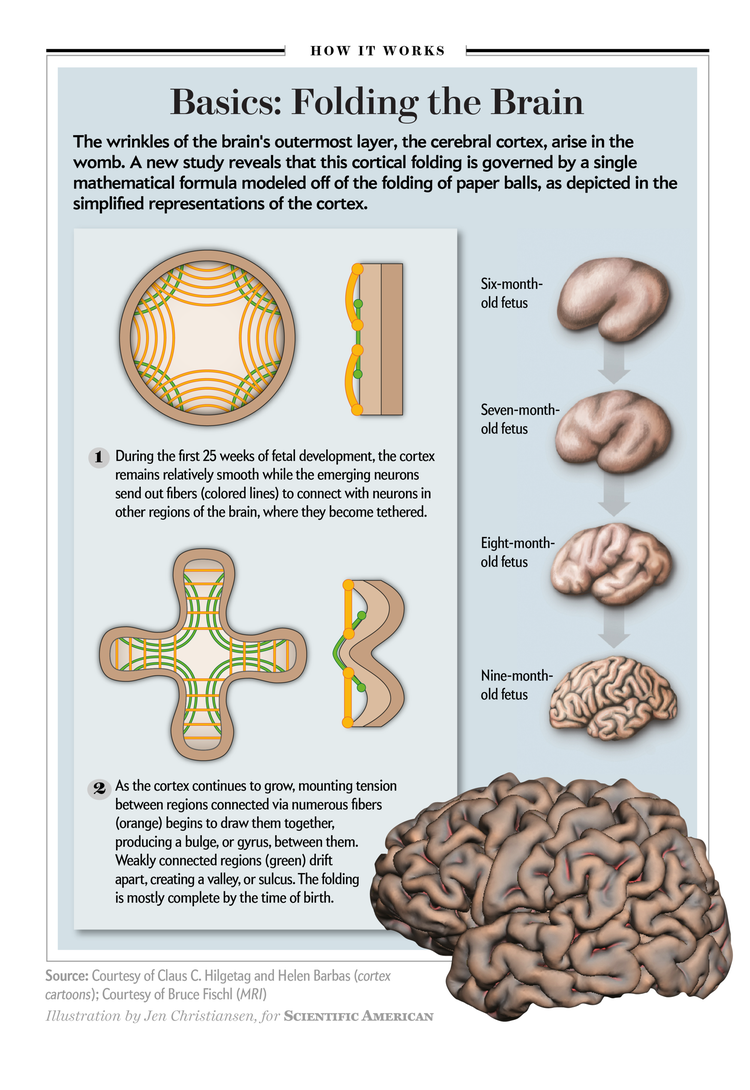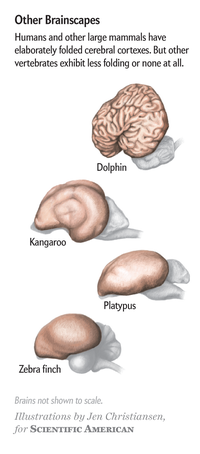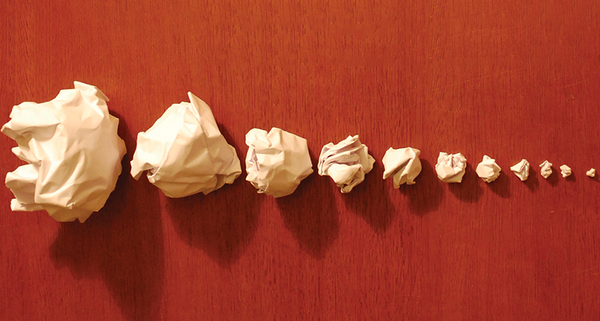A brain and a crisp sheet of office paper may seem to have little in common. But if someone crumples the paper into a ball, they’re holding the solution to one of the most longstanding mysteries of brain development, according to a study published July 2 in Science. As it turns out, the growing mammalian brain folds just like any sheet of office paper, governed by a single mathematical function.
The “brilliant study” represents a significant advance in scientists’ understanding of how the brain develops, says neurologist Arnold Kriegstein of the University of California, San Francisco, who was not part of the study. The research also casts light on the mechanisms behind certain structural disorders of the brain and could inform future efforts to ease those ailments.
Cryptic cortices
The human brain cortex—its outer layer—is an intricately furrowed landscape with ridges called gyri and valleys called sulci. There is a clear advantage to such cortical folding. Having a thinner, folded cortex means information transfer from one point in the brain to another covers less distance and can happen far more rapidly.
On supporting science journalism
If you're enjoying this article, consider supporting our award-winning journalism by subscribing. By purchasing a subscription you are helping to ensure the future of impactful stories about the discoveries and ideas shaping our world today.
Researchers knew that gyri and sulci arise in humans during the third trimester of gestation but could never pinpoint the forces behind their formation. For a long time two explanations held sway but both were riddled with exceptions, according to neuroscientist and co-author Suzana Herculano-Houzel of the Federal University of Rio de Janeiro.
The first hypothesis held that the larger a brain is, the more folded its cortex will be. But the idea failed to account for major outliers like the manatee. Although it has a brain the size of a baboon’s, the latter’s boasts a high degree of folding whereas a manatee’s is almost entirely smooth. Cetaceans also proved a problem; their cortices were more convoluted than would make sense for the sizes of their brains. Dolphin brains, for example, are much more finely grooved than similarly sized human brains.
The second explanation posited that brains fold both as a result of an increasing number of neurons and also as a way to allow this neural growth. The 19th-century neuroanatomist Franz Gall hypothesized that brains folded to allow a much larger cortical surface to fit inside the space of the skull. The alternative would be a cortex that did not fold but expanded like a balloon, an inefficient use of the cramped quarters of the head. Again, paradoxes abounded. Human cortices have three times the number of neurons than elephant cortices, yet human brains are half the mass and far less folded. Baboon and pig cortices display equivalent amounts of folding, yet baboons have 10 times as many neurons as pigs do. These outliers seemed to suggest that different species possess different mechanisms to control cortical folding—that is, each species has its own way of growing a brain.
The Science study both disproves those hypotheses and reconciles anomalies like the manatee with a simple physical law. Grooved and smooth brains alike follow this universal law of nature, regardless of a cortex’s number or arrangement of neurons. Whether or not a brain folds, Herculano-Houzel says, is pure physics.
That’s the way the cortex crumples
The moment of epiphany arrived with the insight of author and physicist Bruno Mota of the Federal University. To model brain folding Herculano-Houzel had graphed a power function derived from the product of cortical surface area and the square root of cortical thickness. Bruno stepped into her office, saw the graph and exclaimed “That’s a sheet of paper!” she recalls. Mota had recognized that the same model that predicted the degree of brain convolution also explained the crumpling of paper balls. To test this theory the researchers simply measured crumpled paper balls with a ruler on Herculano-Houzel’s dining room table.
To see their results you can run essentially the same experiment as the experimenters conducted using four sheets of paper. First, take one sheet, crumple it hard, and set it down. The paper should expand slightly as it releases some energy but eventually it will settle in a crumpled form. “What you have is a system to which you applied forces,” Herculano-Houzel says. “You changed it radically but then it stabilized in a new conformation.”
This last conformation is the ball’s new state of least-effective free energy—the state in which it is most stable. To get a feel for this concept, Mota suggests imagining dropping a ball in a bowl. The ball will settle at the bottom of the bowl, the position of least effective free energy where the ball can remain with least effort. Like crumpled paper, a folded brain will not stray from this new stable state. “You can take it out of the skull, you can poke it, you can chop it into pieces and it remains folded,” Herculano-Houzel says.
Thicker paper leads to fewer folds, and the same is true of brains. Take the remaining three sheets of paper and crumple them as one sheet. This ball will be much larger and harder to fold, simply as a consequence of the material’s added heft. Likewise, thicker cortices fold less and end up with less cortical material hiding below the surface. The crumpled paper model also reveals that a larger surface area led to more folding. The results indicate that as the developing brain grows, the thickness and surface area of tissue at the time forces are applied to it affect how it folds in response.
Inside and outside
Although the forces acting on the paper come from a human hand, the forces applied to an actual cortex arise from several places. Atmospheric pressure applies force outside in as cerebrospinal fluid pushes inside out. There are also pressures exerted by the cells forming the brain as they push outward to grow and expand. This combination of forces, along with the thickness and surface area causes the brain to buckle into its characteristic folds.
The crumpled paper research offers insight into certain developmental brain disorders that result in malformation. For example, lissencephaly results in a smooth brain without any grooves or folds. Researchers understood that this disorder occurs after a disruption in the migration of newborn neurons from their origination point to their final destination in the brain. Although nobody could explain why these brains failed to fold, researchers had noted lissencephalic cortices were four to five times thicker than normal ones. The Science study finally explains the phenomenon of gyrification, showing a thick cortex is much harder to convolute.
“If we can understand how something that basic works or fails to work, there are huge implications now for people who study brain development itself,” Herculano-Houzel says. She points to intermediate progenitor cells, the stem cells involved in brain development, which were long thought to induce brain folding by increasing the number of neurons. Now that the crumpled-paper study shows the number of neurons is probably irrelevant in the folding process, more research is needed to understand the role intermediate progenitor cells play in brain development, she notes.


